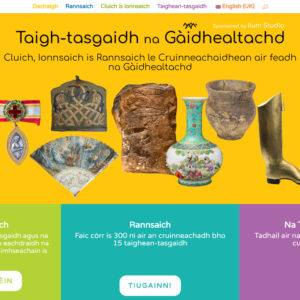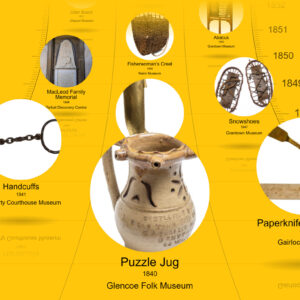Developing the Museum of the Highlands website
Fifteen museums collaborated with Museums and Heritage Highland (MHH) to develop Museum of the Highlands, a digital learning and engagement hub which showcases 300 objects through a mix of images, information, and activities. In this case study Nicola Henderson, Innovation and Network Manager at MHH, shares the story behind the success of this collaborative project.

The project
When the country went into lockdown in 2020, museums across the Highlands (like museums all over the world) looked for new ways to engage with their audiences. Many already had a digital presence, but it was very much secondary to the physical. Now digital was everything. This was particularly true for museum education content. How do you engage with young people and schools when your core asset – your museum – is closed?
As a sector, we experimented with downloadable PDFs, online activities, and virtual visits, to name a few initiatives. These were very successful, not just with our local audiences but with schools and families across the world. Suddenly, we weren’t just offering resources and activities for our local communities but for anyone, anywhere, who was interested. The potential was huge.
However, many of our small-to-medium-sized museums already work over capacity. As we began to re-open our buildings and return to in-person interactions, it became a challenge to capitalise on the opportunities offered by the global reach of our digital output.

It was through our monthly ‘Heritage Cafés’ – informal gatherings on Zoom where members can share challenges and successes, ask questions, and meet with colleagues – that we identified a solution to this problem. During a discussion on education and museums, members proposed a digital hub which could host content and signpost to the unique offers of their organisations. A collaborative approach was suggested, with museums across the Highlands sharing their work, learning, reach, and potential. The idea grew arms and legs and, thanks to funding from Art Fund and Museums Galleries Scotland, has become the Museum of the Highlands digital learning hub.
Starting in the summer of 2022, we spent a year working with museums across the Highlands to create a dynamic digital learning hub which enables children, young people, and teachers to discover and engage with museum collections in new and exciting ways. Fifteen museums from across the region have collaborated and worked closely with our Digital Learning and Interpretation Specialists by bringing objects from their collections together to create a digital portal into the rich history and culture of the Highlands.
The Museum of the Highlands learning hub allows users to access museum collections and learning resources related to objects and topics for use at home or in the classroom, with the functionality to contact museums directly to set up virtual or in-person learning visits.
We’re really excited by the possibilities the Museum of the Highlands – it allows museums to engage with schools (in English and Gaelic) using object-based learning to explore key areas such as skills and values, careers, colonialism and conflict, and much more.
Nicola Henderson, Network and Innovation Manager for Museums and Heritage Highland
Successes
- We created an online learning hub with 350 digitised objects and 200 learning activities.
- It improved our ability to use object-based learning to engage with schools across the world.
- The creation of educational resources and digitisation of objects provided the Highland museum sector workforce with many skills development opportunities.
- By achieving commercial sponsorship, we have ensured that the site can grow and can be maintained without reliance on public grants.
- We have promoted decolonial practice and approaches within the MHH network.
- We’re very pleased to have developed a website which is available in both English and Gaelic.
Challenges
- We underestimated the work involved in managing the metadata for fifteen museums and their collections. Although museums contributed only about 25 objects each, it proved to be a monumental task!
- Communication wasn’t always perfect as things changed and moved.
- Conflicting availability and schedules made it almost impossible to set up a teacher and young person steering group. We created the group but often met with its members individually to ensure their input was still front and centre.
Impact
We don’t yet know the full impact of Museum of the Highlands, as our project was focused around the development and launch of the hub. Our next step is to build a programme of school and education group events with the sponsorship money we achieved.
It’s our hope that the museums involved will generate income through increased physical and virtual visits, as well as deeper connections with local schools. For now, however, we do know the impact of the project on our network:
- Museums now have a suite of assets and increased knowledge on how to use these to engage schools and young people. This is already influencing their plans for future education activities.
- The website’s timeline of objects has had a big impact beyond our target groups of schools and families. It’s a useful tool which is accessed and enjoyed by diverse audiences.
- We now have a greater understanding of how to successfully deliver a collaborative project
- It was important for us to take a de-colonial approach to this project. This has inspired our members to take action on the decolonisation of their own museums.
Guidance
- Plan how to gather and manage the metadata needed for a project of this nature well in advance, and allow enough time to do it well.
- Be flexible when engaging with teachers, as they are very time poor. You’ll need to work to their availability.
- Deliver over the winter period as museums are busy in the summer!
- If you’re planning to make your site bilingual, allow for additional costs and time to ensure that Gaelic is embedded from the start.